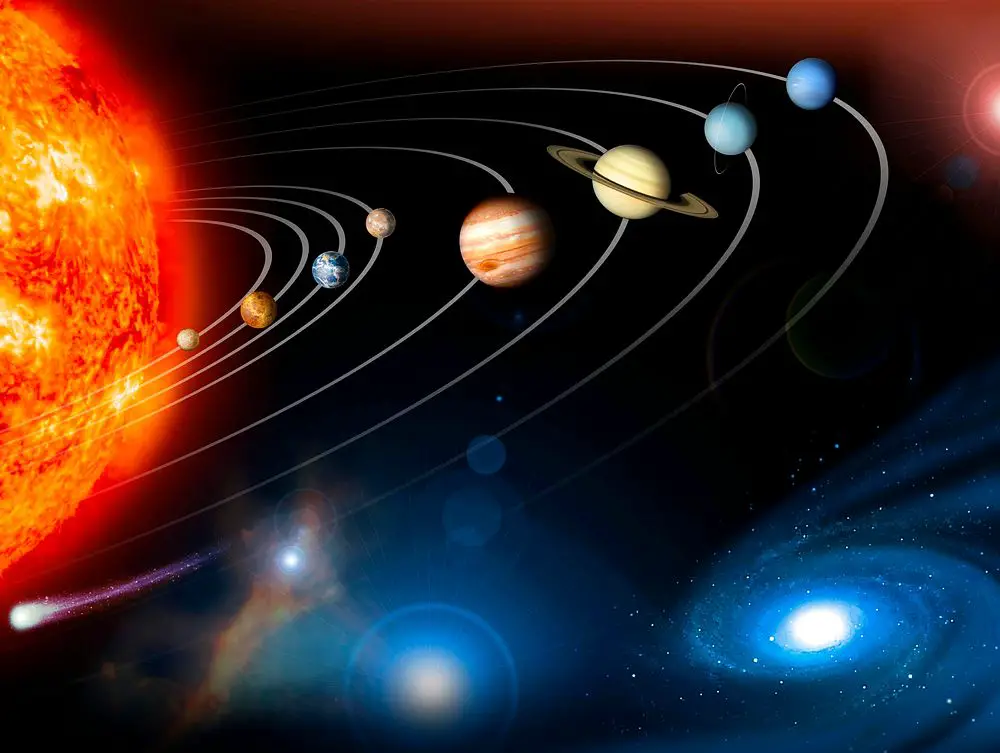Our home in the vast cosmos, the solar system, is a breathtaking realm full of amazing extremes. All of the planets have unique and fascinating climates, with temperatures ranging from the freezing and icy depths of Neptune, the planet that is furthest from the Sun, to the scorching and merciless heat of Mercury, the planet that is nearest to the Sun. Numerous factors affect these cosmic entities’ temperature variations: their distances from the Sun, the complex makeup of their atmospheres, the slight axial tilts that determine their seasons, and even their distinct albedo or reflectivity characteristics that affect how they interact with solar radiation. These components’ complex interactions create a captivating picture of the various thermal landscapes that exist in our cosmic vicinity.
- Mercury: The Closest Planet to the Sun
Mercury is not the hottest planet, even though it is the nearest to the Sun. During the day, the average temperature is almost 167°C (332°F). However, at night, the temperature can drop to -173°C (279°F) because to the thin atmosphere’s inability to retain heat.
Mercury’s distinct features are the cause of its huge temperature swings. The planet’s surface heats up considerably during the day due to the tremendous solar radiation it receives from the Sun because of its close proximity to it. However, as Mercury faces away from the Sun at night, the lack of an atmosphere prevents it from retaining the heat, which causes the temperature to plummet quickly.
Mercury is a fascinating astronomical entity to examine because of the dramatic contrast between its blistering hot days and its extremely cold nights. Researchers are learning more about the severe temperature swings and atmospheric dynamics of this unique planet as they continue to study its mysteries.
- Venus: The Hottest Planet
Often called Earth’s “sister planet,” Venus is an intriguing object in our solar system. It has a dense atmosphere that is mostly made of carbon dioxide and sulfuric acid clouds. Venus is the warmest planet in our solar system because of its distinct composition, which produces a significant greenhouse effect. Venus experiences unmatched blistering heat, with an average temperature of 462°C (864°F). Because of its harsh environment, it is an intriguing topic for scientific research and investigation.
- Earth: Our Home Planet
The average surface temperature of our breathtakingly gorgeous blue planet, Earth, with its enormous oceans and breathtaking landscapes, is roughly 14°C (57°F). This comfortable and temperate temperature creates the perfect environment for liquid water to exist. Water is an essential element that supports an astounding variety of life forms, from the tiniest microbes to the most intricate creatures. Earth is a fascinating and truly habitable oasis amid the great expanse of the universe because of this amazing attribute, as well as the unique combination of our planet’s atmosphere, geology, and pure luck.
- Mars: The Red Planet
The reddish hue of Mars, the fourth planet from the Sun, is commonly attributed to the presence of iron oxide, or rust, on its surface. This is an interesting planet with a very thin atmosphere mostly made of carbon dioxide. Mars has an incredibly low average temperature of -63°C (-81°F), with extremes of -140°C (-220°F) in the winter polar caps and a comparatively warmer 20°C (70°F) on summer days close to the equator. Mars’s varied climate makes it a fascinating planet to study scientifically and a visually appealing object in our solar system.
- Jupiter: The Gas Giant
Our solar system’s largest planet, Jupiter, is an intriguing gas giant without a solid surface. Its enormous bulk and size give it a strong gravitational pull that alters the orbits of other celestial bodies in its vicinity. With an average temperature of about -145°C (-234°F), Jupiter’s upper atmosphere is extremely cold, creating a chilly atmosphere. But when we get further into its center, the circumstances change significantly. Temperatures climb sharply toward the planet’s center, hitting a searing 24,000°C (43,000°F) mark. Jupiter’s dramatic features are highlighted by this sharp temperature difference, which makes it an intriguing target for scientific research and exploration.
- Saturn: The Ringed Planet
Another gas giant planet with a comparable temperature profile to Jupiter is Saturn, the majestic planet best known for its breathtaking ring system. The average temperature in the upper atmosphere is a very cold -178°C (288°F). But as we travel closer to its center, the temperature rises dramatically to an incredible 11,700°C (21,000°F). The remarkable intricacy of this celestial splendor is brought to light by the sharp contrast in temperature.
- Uranus: The Ice Giant
The planet Uranus, sometimes known as the “ice giant,” is one of the most interesting in our solar system. It is the coldest planet, with an average temperature of -216°C (357°F). The main causes of Uranus’s extreme cold are its unusual axial tilt and large distance from the Sun, which produce long nights and extremely cold temperatures. Despite the planet’s frozen surface, astronomers and scientists continue to be enamored with Uranus because of its peculiar atmosphere and distinctive composition.
- Neptune: The Farthest Planet
Neptune is an intriguing planetary body that is the farthest known planet from the Sun. It can withstand extremely cold temperatures, with an average temperature that is similar to Uranus, at about -214°C (353°F). Neptune has some of the fastest and most vigorous winds in the solar system, despite its great distance from us. It is a remarkably dynamic planet with tremendous winds that may reach astounding speeds of up to 2,100 kilometers per hour.
Seeing how variable the temperatures are on the many planets in our solar system is amazing. The diversity of life on Earth helps us comprehend not only our own planet but also the conditions that support life as we know it and the likelihood that life exists elsewhere in the cosmos.
Sources
- https://solarsystem.nasa.gov/planets/overview/
- https://www.space.com/17816-planet-temperatures.html
- https://www.universetoday.com/35580/temperature-of-the-planets/
![]()
